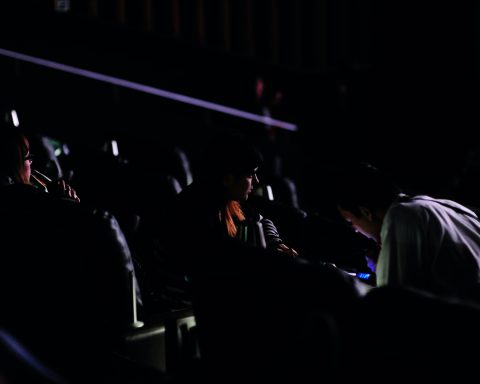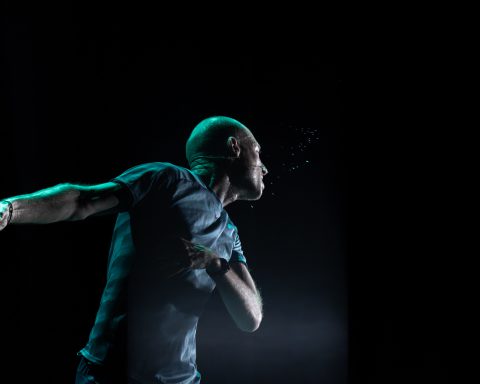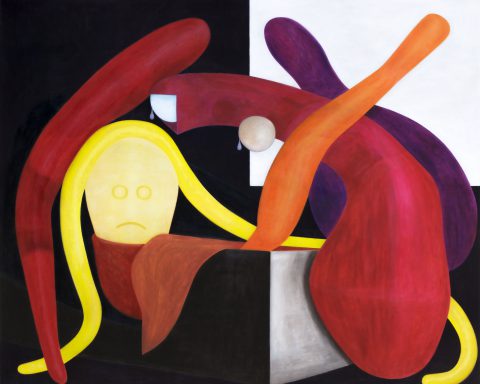I wrote this for the New York art blog Art-Rated in March 2015. It was before I started writing for Leipglo. I think this work is relevant, so here it is.
Last night I saved the life of a fish by ordering a pizza.
I was at KKW talking to Tawainese artist Tin-Tong Chang. He was a little more than halfway through a two-week performance installation curated by Candace Goodrich. At the 12 Feb vernissage, I skipped another opening because I was memorized by a pool of fish. After a couple of hours, I could already tell they had totally different faces and some even came to me and let me touch them.
This is something that Tin-Tong doesn’t engage in. He doesn’t want to give them individuality. He is the human element in a system he can’t afford to buck. His life literally depends on it.
The system “Whence do you know the happiness of fish?” consists of a man who feeds fish and they, in turn, feed him.
Tin-Tong’s work analyzes the relationship between science, technology and society. The fish are sturgeon. They have never been in the wild. Sturgeon come in 25 species and many are endangered or on the critical list because of overfishing for their precious (up to 800 USD per ounce) caviar. Females reach maturity at the age of 10 and then are cut open, the eggs removed and their flanks striped for their flesh.
[spacer height=”20px”]

[spacer height=”20px”]
The 3-year-old fish in Tin-Tong’s installation are part of the work of German biologist Andreas von Bresinsky, who is trying to design the most efficient filtering system. The one used is a prototype by Dresden-based industrial filtration company DAS, making it the only one of its kind. It is a system within itself and uses symbiosis to create a natural environment in the fish pool.
Tin-Tong jokes that the fish are living in better conditions than he is, but in fact that’s the truth. This pool was stocked with 50 fish when there are usually hundreds in the same size pool.
The water is constantly monitored for temperature, pH and other factors. So far the alarm has gone off twice and Tin-Tong has immediately called the biologist, who has come and adjusted the system. In the process, Tin-Tong has learned a lot about sturgeon, for instance that they can only swim forward.
He has also learned a little German. He’s heard the word “scheiße” enough times that it features on his wall of drawings.
[spacer height=”20px”]

[spacer height=”20px”]
Tin-Tong uses traditional ink on paper in a totally modern way, making humorous drawings inspired by his surroundings. Captions such as “Every fish has a nightmare about a hand in a pool”, “Eternal Holiday”, “Boring” and “Most of the time I feel my life is falling apart” are illustrated with reference to the system he is in.
This humorous outlook is also reflected in the title of the installation – “Whence do you know the happiness of fish?” – which is taken from 3rd century China when philosopher Chuang Tzu criticized Daoism in the following story.
Chuang Tzu and Hui Tzu were strolling along the dam of the Hao River when Chuang Tzu said, “See how the minnows come out and dart around where they please! That’s what fish really enjoy!”
Hui Tzu said, “You’re not a fish – how do you know what fish enjoy?”
Chuang Tzu said, “You’re not I, so how do you know I don’t know what fish enjoy?”
Hui Tzu said, “I’m not you, so I certainly don’t know what you know. On the other hand, you’re certainly not a fish ‑ so that still proves you don’t know what fish enjoy!”
Chuang Tzu said, “Let’s go back to your original question, please. You asked me how I know what fish enjoy ‑ so you already knew I knew it when you asked the question. I know it by standing here beside the Hao.”
- Zhuangzi, 17, tr. Watson 1968:188-9
Makes one think, right? Tin-Tong has had plenty of time to think. He has thought about systems. In London the homeless are outside the system. They are very evident and wait outside the cash machine. He says they can be quite aggressive. Of course he’d like to give something to each and every one, but that would leave him on the street himself.
In China the poor are part of the system. They are taken care of by family and friends. You don’t see that they are poor. He has noticed that here, in Germany, he hasn’t seen people begging.
However, he has experienced the German system first hand. Someone called animal protection in the fishes’ defense. They came out and saw that everything was in order. But they asked him to kill a fish.
Naturally he was nervous, as he is every time he has to kill one. This is something that has not gotten easier in a week even though he has killed one each day. He says he will stay away from meat for a while after this. Killing a fish is hard enough, but now he really can’t stomach the killing of a cow or pig. They breathe like us, have the same organs we do.
[spacer height=”20px”]
[spacer height=”20px”]
How in the world did he come up with the idea? That again comes from his personal history. In Taiwan everything seems commonplace, but now that he lives in Europe he can see that different cultures think in entirely different ways. Traditionally, Asian artists share historical culture. He sees value and interest in current culture.
Right this minute in Taiwan, there are lots of people sitting in plastic chairs around pools fishing for shrimp in immense indoor fishing halls for entertainment. Under the same roof someone is singing karaoke and someone else is playing video games.
From production in Asia to consumption in the West, we are all part of the same system.









